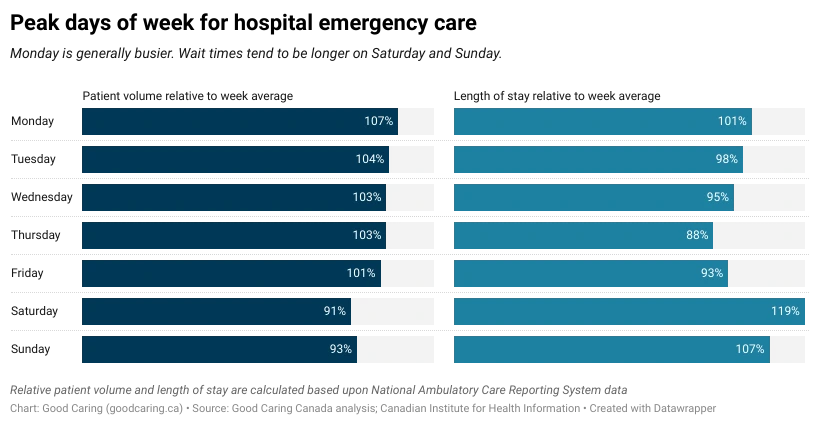Emergency room (ER) wait times in Ottawa have become a significant concern, with recent data indicating that local hospitals often exceed provincial averages. The strain is no longer an occasional inconvenience—it’s a growing public health challenge affecting thousands of residents each month.
Patients in need of urgent attention often find themselves waiting for hours in overcrowded waiting rooms, where delays can have serious consequences for outcomes and comfort.
For instance, the Ottawa Hospital General Campus reports an average wait time of 2.6 hours for a first assessment by a doctor, surpassing the Ontario average of 1.6 hours. Similarly, the Civic Campus has an average wait time of 2.8 hours. These delays are not limited to night shifts or weekends; they are now common throughout the week, at all hours.
As Ottawa’s hospitals continue to operate over capacity, residents must be prepared—not only for the long waits, but also for the increased health risks associated with crowded public spaces.
💡 Consider advice for protecting yourself from germs and preparing for long wait times.
Protect Yourself & Loved Ones
Crowded waiting rooms can increase your risk of exposure to diseases. Hospitals are often filled with patients with contagious conditions. Protect yourself as you wait for emergency care.
- 😷 Wear a mask. Protect yourself from respiratory illnesses. Masks are particularly effective during flu seasons.
- 🧴 Practice hand hygiene. Contact with shared surfaces, such as chairs, doorknobs, and check-in kiosks, can expose you to pathogens. Regularly wash your hands with soap and water. Use a hand sanitizer.
- 📱 Protect belongings. Germs can transfer to your belongings. Keep personal items, such as phones and bags, away from shared surfaces. Sanitize personal items with disinfecting wipes at home.
- 💪🏼 Boost your immune system. Build an extra layer of protection with supplements. Vitamin C, Vitamin D, and zinc can boost immune function to fight infections.
Prepare for Long Wait Times
Long wait times are often unavoidable, especially during peak times or for non-urgent conditions. Prepare for an extended stay to be more comfortable and to reduce stress.
- 🧣 Bring comfort aids. Prolonged sitting can be uncomfortable, especially for older adults. Bring a neck pillow, lumbar cushion, and percussion massager.
- 🎮 Bring entertainment. Entertainment can reduce stress and boredom. Learn how to make effective use of time in the waiting room.
- 🎧 Wear noise-cancelling headphones. Hospitals can be noisy environments, which can increase stress. Wear noise-cancelling headphones to block out the commotion.
- 🍪 Pack healthy snacks. Hospitals may have limited food options. Bring snacks to sustain energy levels. Check with the doctor or nurse practitioner if fasting is required. Consider trail mix, whole-grain crackers or granola bars.
- 🧦 Dress comfortably. Hospitals can have variable temperatures. Dress in layers. Wear comfortable clothing.
Find Emergency Care in Ottawa
Ottawa is served by five primary care facilities:
- Children’s Hospital of Eastern Ontario (401 Smyth Road, Ottawa)
- Hôpital Montfort (713 Montréal Rd, Ottawa)
- Queensway Carleton Hospital (3045 Baseline Road, Nepean)
- Ottawa Hospital – Civic Campus (1053 Carling Avenue, Ottawa)
- Ottawa Hospital – General Campus (501 Smyth Road, Ottawa)
Understand Systemic Challenges
Ottawa’s emergency room wait times are among the longest in Ontario, driven by systemic inefficiencies, resource shortages, and demographic pressures.
As a healthcare hub for Eastern Ontario, Ottawa absorbs critical cases from surrounding rural hospitals, further straining capacity. Unlike Toronto, the city lacks a network of secondary hospitals to distribute patient volume.
A province-wide healthcare worker shortage has hit Ottawa especially hard. The city competes with Toronto and Montreal for talent, often losing out to higher salaries and less stressful work environments. Burnout, excessive patient loads, and administrative burdens drive staff departures. Ottawa’s bilingual hiring requirements further limit recruitment, slowing efforts to fill vacancies.
An aging population adds pressure, with seniors requiring ER services more frequently. Meanwhile, a family doctor shortage forces many residents to rely on emergency rooms for routine care, increasing wait times for all patients.
Despite efforts to divert non-urgent cases to walk-in clinics, Ottawa’s ERs remain overwhelmed. Without significant investment in staffing, infrastructure, and alternative care options, wait times will continue to rise, leaving patients waiting even longer for critical treatment.
Plan Ahead for Peak Times
Planning your visit to the emergency department can significantly impact wait times, particularly if the medical issue is not urgent.

Mondays tend to be the busiest day of the week in hospital emergency departments. The accumulation of non-emergency cases over the weekend often result in a surge of patient volume on the first work day of the week.
If your condition allows for flexibility in seeking care, consider the day of the week for your visit. Avoid Mondays and weekends.

The time of day is unlikely to significantly reduce wait times, as hospitals align staff availability with patient volumes.
During standard business hours, from morning to early evening, full staffing is in place. However, higher patient volumes during these times can create bottlenecks. Even with more medical personnel, increased demand can still lead to longer waits as emergency departments handle the influx of patients.
Late-night and early-morning hours may seem ideal due to fewer patients. However, reduced staffing during these hours often negates the benefit of a smaller patient load. Patients may still face long waits due to limited healthcare providers.

Demand seasonality can affect wait times in emergency departments across Canada, particularly among younger patients. Young children, aged 0 to 5, see a rise in emergency visits during autumn, with a notable decline in the summer months. Children, aged 5 to 19, experience a peak in spring and a similar decrease in the summer.
Adults, aged 20 to 64, generally show consistent demand for emergency care throughout the year. Seniors over 65 also follow a steady pattern, with minimal seasonal fluctuations.
Consider Other Care Options
If medical conditions are not urgent, you can consider alternative care options:
- Family doctors can serve as the primary point of contact for managing ongoing or non-urgent medical concerns. They provide comprehensive and personalized care, often maintaining detailed records of a patient’s medical history, which facilitates continuity of care and long-term management of health conditions.
- Walk-in clinics can offer convenient medical services for minor injuries or illnesses without the requirement of an appointment.
- Urgent care centres can provide medical attention for non-life-threatening conditions, such as minor fractures or severe flu symptoms. These centres typically offer faster service compared to emergency departments.
- Nurse practitioner-led clinics can provide diagnosis and treatment for common injuries and illnesses, prescriptions, and blood and diagnostic tests. NP-led clinics are particularly valuable if family doctors are not available in the area.
Learn wait times for common medical procedures in Ontario:







